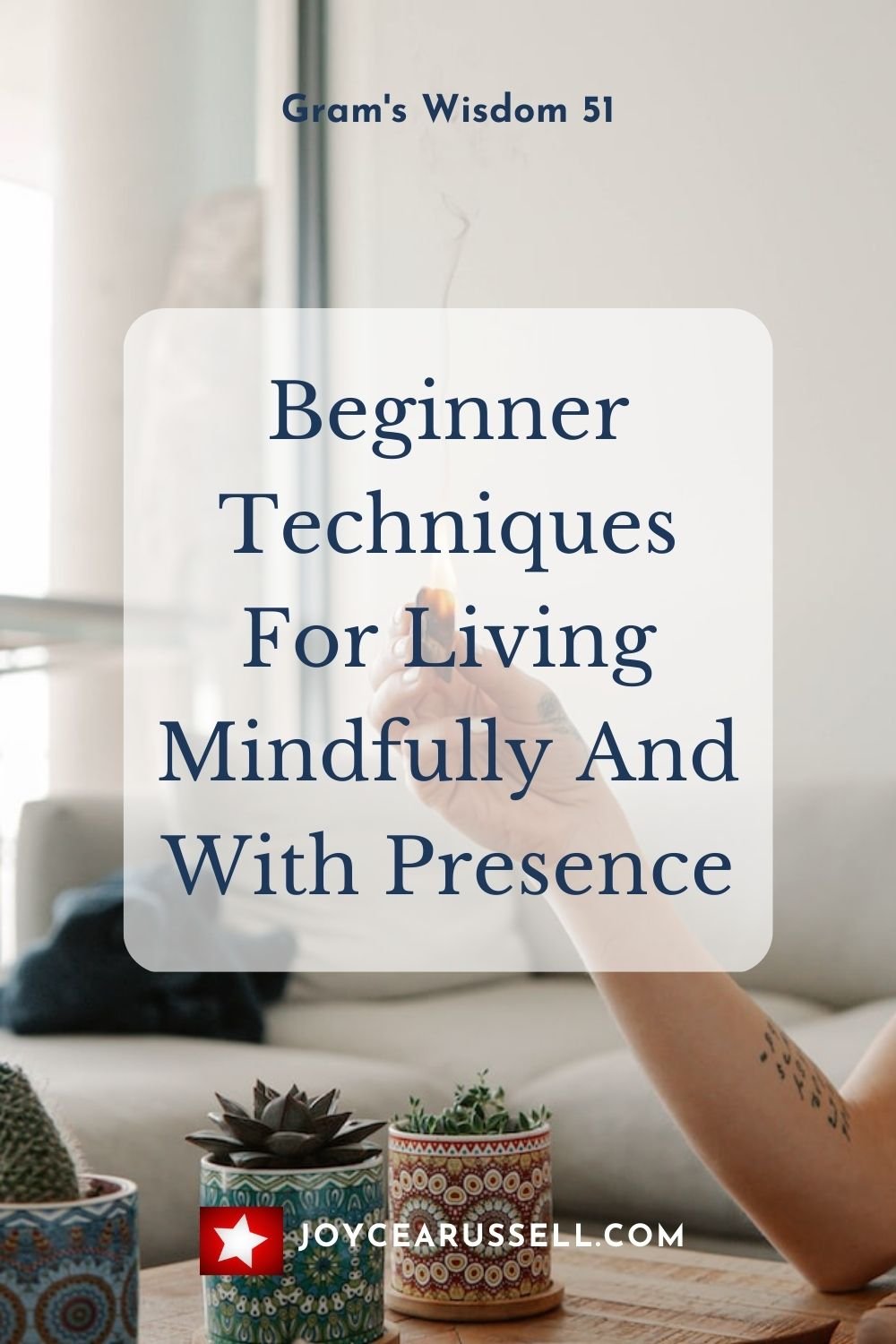Gram’s Wisdom 51 Stop, look and listen.
Though the terms were foreign to her, my Gram practiced mindfulness and presence every day of her life. She called what she did focusing on the here and now. When I was young, she explained to me that I should stop and look at how much beauty there is to see everywhere in every season. And stop to listen to the hum of bees, water rushing over rocks, or the songs of birds.
Many were the times when she would light a scented candle, and we would prepare a pot of tea together in the evening. Sometimes we would talk quietly and listen to hear what the other had said. At other times we would listen to music that we both loved or just sit in companionable silence.
In the early hours of the morning, Gram and I would sit together on the porch listening to the birds sing and watching the sunrise. She would tell me what she was grateful for. And I was absorbing a mindfulness practice that had no name but has grounded me and carried me every day of my life. Thanks, Gram.
The central ideas of mindfulness and presence.
Mindfulness and presence are two central ideas today. With the hustle and bustle of everyday life, it can be difficult to find time to focus on the present moment. However, mindfulness and presence techniques can help to bring tranquility and focus into your life.
Presence and mindfulness are not only important for your mental health, but they can also help you to be more productive and efficient in your life. When you’re present, you can focus on what is in front of you and not be distracted by your thoughts. When you’re mindful, you can be aware of your thoughts and feelings without getting caught up in them or judging them.
Various mindfulness practices are easy and accessible to new practitioners. Try implementing some of the techniques below and see how quickly you can get a grasp on your thoughts and shift them to an inspiring mindset.
Breathe.
One way to practice mindfulness is easily accessible at any time - breathing. Focusing on the breath is a great way to calm the mind. And provide a tranquil environment in which the mind can slow down and allow for curiosity and creativity. Breathing deeply brings calm to the mind and the body and adds fresh oxygen to our brain which allows new thoughts to develop. Breathing brings the body to calmness and regulates the nervous system.
One breathing technique is to focus on your inhales and exhales, counting each one as you breathe. You can also focus on the feeling of your breath as it moves in and out of your body. Another breathing technique is to imagine your breath as a wave, flowing in and out of your body. You can also bring your awareness to your body and how it feels to be breathing. If you notice tension in your body, you can focus on relaxing the muscles.
“Eternity belongs to those who live in the present.”
Drink tea.
One way to bring mindfulness to the moment is to drink tea with a calm and peaceful quietude. When we drink tea, we can also take deep breaths and take breaks in between sips to allow spaciousness in the mind. This is a simple task, but the key is to be present in the moment and pay attention to the act of drinking tea.
Take a few deep breaths and focus your attention on the act of organizing the tea. Which do you prefer a mug or teacup and saucer? In what form do you like your tea a tea bag or loose-leaf tea don’t forget the tea ball. As you prepare the tea, listen to the sound of the boiling water. Inhale the scent of the tea as it rises with the steam from the cup. Once the tea has steeped, sit down, and take a few slow sips, savoring the flavor and the warmth.
Notice how your body feels as you drink the tea. Pay attention to your thoughts and emotions, letting them come and go without judgment. Just be with the tea and the moment. Drinking tea can be an excellent way to relax and de-stress. The key is to be mindful of the experience and to be present in the moment. By paying attention to the sights, sounds, and sensations, you create a sense of serenity and peace.
Write a gratitude list.
Making a list of gratitude is an amazing practice of mindfulness. It is a practice of noticing the gifts, grace, and good in your life. Gratitude lists are a way of acknowledging the abundance in your life. Some people find it helpful to keep a daily gratitude list, others do it weekly, or only occasionally. However often you choose to do it, gratitude lists are a way of reminding you of the good things you have. They can also help you to focus on the positive aspects of life.
Each morning, evening, or whenever you can make time throughout the day, sit with a pen and paper and write a list of things you are grateful for. Maybe you set a timer for 3 minutes to write about what you are grateful for or commit to writing down 3 things from the day that you are grateful for. Items on a gratitude list could be big or small, something from the past, or something happening in the present time. Bringing gratitude into the mind is a great practice and can lead to a greater number of positive feelings and recognition of positive experiences.
Here is a sample gratitude list.
I am grateful for my abundant health.
I am grateful to my family and friends.
I am grateful for my job.
I am grateful for the shelter of my home.
I am grateful for my dog, Houdini.
I am grateful for my ability to walk.
I am grateful for the sun shining today.
I am grateful for the rain that watered my garden.
I am grateful for the food in my refrigerator.
I am grateful for my bed, where I will sleep comfortably tonight.
Light a candle.
Lighting a candle is another way to bring mindfulness into your life. As you light the candle, take a moment to notice the sensation of touching the match to the wick. Feel the heat of the flame as it springs to life, the scent of the smoke, and the sight of the flickering flame. Take the time to sit with it and watch it. Fire is one of the most fundamental aspects of nature. It reminds us that we are strong and peaceful and ever-changing.
You can light a candle and sit calmly in front of it and enjoy its presence. Watching a flame flicker can be incredibly calming. Don’t try to control your thoughts or stop them from coming. Allow them to come and go as they please while you concentrate your attention on the flame. It’s okay if your mind wanders. Just return your focus to the flame. As you practice, you’ll find that you can focus on the flame for longer periods.
Listening Meditation.
Listening is one of the most basic and important human skills. You rely on it to communicate, learn, and interact with others. Regrettably, in the fast-paced, modern world, it’s all too easy to get caught up in our thoughts and fail to listen to what others are saying. Mindfulness and presence techniques can help you slow down, focus your attention, and listen to what others have to say.
A practice of mindfulness that can be implemented anywhere is an audible or listening meditation. Wherever you are, you can take a moment to listen to the sounds around you and recognize where you are and what your sense of hearing is experiencing. Listen to the birds singing, the breeze rustling through the trees, the sounds of traffic, or whatever else you can hear. Don’t try to do anything with the sounds, just be aware of them. If your mind wanders, simply bring your attention back to the surrounding sounds. Listening mindfulness is a practice that can be transformative for attention to the present moment.
Benefits of being present.
When you are fully present in the moment, you are open to new experiences and new ways of seeing things. You are also better able to manage difficult situations and make wiser decisions. The following are additional benefits of being present:
You are better able to appreciate the good things in life.
You are better able to connect with others.
You are better able to find meaning in life.
You are better able to live in the present moment.
You are better able to let go of the past and embrace the future.
Mindfulness and presence techniques can be used to improve your mental and emotional well-being. Practicing these techniques can help you to become more aware of your thoughts and feelings, and to manage any stress and anxiety you may have. With regular practice, you may find that you concentrate better, sleep better, and feel more relaxed and positive.
My final thoughts are.
If you're looking to add mindfulness and presence practices to your life, there are many different techniques you can try. Some key techniques include focusing on your breath and noticing your thoughts and emotions. By incorporating these techniques into your daily life, you can begin to experience the benefits of mindfulness, such as increased focus, decreased anxiety, and improved well-being.
For more information, read these posts.
10 Best Reasons For You To Become Mindful.
Thank you for reading this post.




